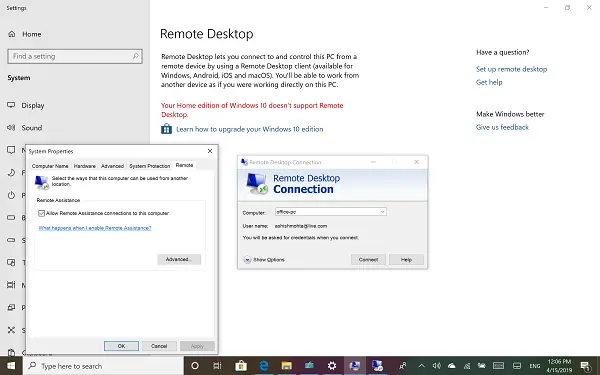

- ALTERNATE WINDOWS REMOTE DESKTOP CLIENT HOW TO
- ALTERNATE WINDOWS REMOTE DESKTOP CLIENT SOFTWARE
- ALTERNATE WINDOWS REMOTE DESKTOP CLIENT PC
This requires signing up for a service (a few free ones are DynDNS,, and No-IP) and configuring your router with your account details so your host name stays updated when your IP address changes.Ĭonnecting to Your Windows XP PC via Web Browser
Domain or Host Name: If you have a dynamic IP address (or you don’t want to remember a static address), it’s best to use a domain or host name to connect to your Remote Desktop PC. You can call your ISP to see if you have a dynamic IP address or a static address. This type of address is typical on most residential, and even small business, Internet connections. A word of caution: Your Internet IP changes, anywhere from daily to monthly, if you have a dynamic IP address. You can find your Internet IP address on your router’s status pages, under the WAN or Internet section, or you can google it to be detected by a Web site service. This is the number you want to use when connecting to your Remote Desktop PC when away from the home or office.  Internet IP Address: This number is the IP address of your Internet connection or modem, assigned by your Internet service provider (ISP), used to identify computers or networks on the web. You can find a computer’s IP address by looking through the network connection status details in Windows. Like with the Computer Name you can use this only when you are on the same network. Local IP Address: This number (such as 192.168.1.103) also helps identify computers on a local network, and it is used by the network components when sending and receiving data. You can find this value on a computer by right-clicking the My Computer or Computer icon on your desktop or the Start menu, clicking Properties, and if in Windows XP, you need to click the Computer Name tab. You can use this only when you are on the same network as the Remote Desktop computer not if you are connecting from a computer outside your home or office. Computer Name: This is the Computer Name value of the computer that Windows uses to help you identify computers on a local network. You have, though, a few different items you can use as a path, which include: Once the program loads, you can enter the path to your Remote Desktop PC into the Computer field and hit the Connect button. Start>All Programs>Accessories>Remote Desktop Connection Figure 1 shows an example of the program. First, we’ll connect using the traditional client program (called Remote Desktop Connection) that’s installed by default on most Windows versions. Now you are all ready to remotely connect to your PC either from another computer on your network or from any computer on the Internet. Connecting to Your PC with the Traditional Client
Internet IP Address: This number is the IP address of your Internet connection or modem, assigned by your Internet service provider (ISP), used to identify computers or networks on the web. You can find a computer’s IP address by looking through the network connection status details in Windows. Like with the Computer Name you can use this only when you are on the same network. Local IP Address: This number (such as 192.168.1.103) also helps identify computers on a local network, and it is used by the network components when sending and receiving data. You can find this value on a computer by right-clicking the My Computer or Computer icon on your desktop or the Start menu, clicking Properties, and if in Windows XP, you need to click the Computer Name tab. You can use this only when you are on the same network as the Remote Desktop computer not if you are connecting from a computer outside your home or office. Computer Name: This is the Computer Name value of the computer that Windows uses to help you identify computers on a local network. You have, though, a few different items you can use as a path, which include: Once the program loads, you can enter the path to your Remote Desktop PC into the Computer field and hit the Connect button. Start>All Programs>Accessories>Remote Desktop Connection Figure 1 shows an example of the program. First, we’ll connect using the traditional client program (called Remote Desktop Connection) that’s installed by default on most Windows versions. Now you are all ready to remotely connect to your PC either from another computer on your network or from any computer on the Internet. Connecting to Your PC with the Traditional Client ALTERNATE WINDOWS REMOTE DESKTOP CLIENT HOW TO
In addition, we’ll figure out how to bring up the remote connection via a web browser. We’ll discover the different addresses we can enter into the client program, to establish the remote connection. In this tutorial, we’ll go step-by-step on how to connect to the remote computer.
ALTERNATE WINDOWS REMOTE DESKTOP CLIENT SOFTWARE
In previous tutorials, we stepped through setting up the traditional Remote Desktop feature of Windows, enabled remote access via a web browser, and configured our firewall software and router to allow the connections.





 0 kommentar(er)
0 kommentar(er)
